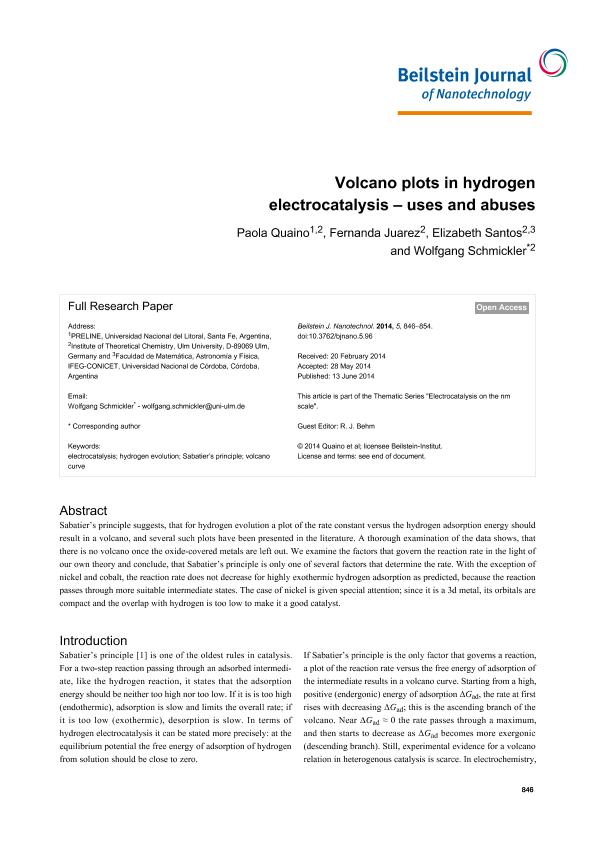Mostrar el registro sencillo del ítem
dc.contributor.author
Quaino, Paola Monica

dc.contributor.author
Juarez, Maria Fernanda

dc.contributor.author
Santos, Elizabeth del Carmen

dc.contributor.author
Schmickler, Wolfgang

dc.date.available
2017-12-20T19:56:58Z
dc.date.issued
2014-06
dc.identifier.citation
Schmickler, Wolfgang; Santos, Elizabeth del Carmen; Juarez, Maria Fernanda; Quaino, Paola Monica; Volcano plots in hydrogen electrocatalysis: uses and abuses; Beilstein-Institut; Beilstein Journal of Nanotechnology; 5; 6-2014; 846-854
dc.identifier.issn
2190-4286
dc.identifier.uri
http://hdl.handle.net/11336/31169
dc.description.abstract
Sabatier’s principle suggests, that for hydrogen evolution a plot of the rate constant versus the hydrogen adsorption energy should result in a volcano, and several such plots have been presented in the literature. A thorough examination of the data shows, that there is no volcano once the oxide-covered metals are left out. We examine the factors that govern the reaction rate in the light of our own theory and conclude, that Sabatier’s principle is only one of several factors that determine the rate. With the exception of nickel and cobalt, the reaction rate does not decrease for highly exothermic hydrogen adsorption as predicted, because the reaction passes through more suitable intermediate states. The case of nickel is given special attention; since it is a 3d metal, its orbitals are compact and the overlap with hydrogen is too low to make it a good catalyst.
dc.format
application/pdf
dc.language.iso
eng
dc.publisher
Beilstein-Institut

dc.rights
info:eu-repo/semantics/openAccess
dc.rights.uri
https://creativecommons.org/licenses/by/2.5/ar/
dc.subject
Electrocatalysis
dc.subject
Hydrogen Evolution
dc.subject
Sabatier'S Principle
dc.subject
Volcano Curve
dc.subject.classification
Otras Ciencias Químicas

dc.subject.classification
Ciencias Químicas

dc.subject.classification
CIENCIAS NATURALES Y EXACTAS

dc.title
Volcano plots in hydrogen electrocatalysis: uses and abuses
dc.type
info:eu-repo/semantics/article
dc.type
info:ar-repo/semantics/artículo
dc.type
info:eu-repo/semantics/publishedVersion
dc.date.updated
2017-12-18T15:06:20Z
dc.journal.volume
5
dc.journal.pagination
846-854
dc.journal.pais
Alemania

dc.journal.ciudad
Frankfurt
dc.description.fil
Fil: Quaino, Paola Monica. Universidad Nacional del Litoral. Facultad de Ingeniería Química. Programa de Electroquímica Aplicada e Ingeniería Electroquímica; Argentina. Consejo Nacional de Investigaciones Científicas y Técnicas. Centro Científico Tecnológico Conicet - Santa Fe; Argentina
dc.description.fil
Fil: Juarez, Maria Fernanda. Consejo Nacional de Investigaciones Científicas y Técnicas. Centro Científico Tecnológico Conicet - Santa Fe; Argentina. Institute of Theoretical Chemistry; Alemania. Universitat Ulm; Alemania
dc.description.fil
Fil: Santos, Elizabeth del Carmen. Institute of Theoretical Chemistry; Alemania. Universitat Ulm; Alemania. Consejo Nacional de Investigaciones Científicas y Técnicas. Centro Científico Tecnológico Conicet - Córdoba. Instituto de Física Enrique Gaviola. Universidad Nacional de Córdoba. Instituto de Física Enrique Gaviola; Argentina. Universidad Nacional de Córdoba. Facultad de Matemática, Astronomía y Física; Argentina
dc.description.fil
Fil: Schmickler, Wolfgang. Institute of Theoretical Chemistry; Alemania. Universitat Ulm; Alemania
dc.journal.title
Beilstein Journal of Nanotechnology
dc.relation.alternativeid
info:eu-repo/semantics/altIdentifier/url/https://www.beilstein-journals.org/bjnano/articles/5/96
dc.relation.alternativeid
info:eu-repo/semantics/altIdentifier/doi/http://dx.doi.org/10.3762/bjnano.5.96
Archivos asociados
